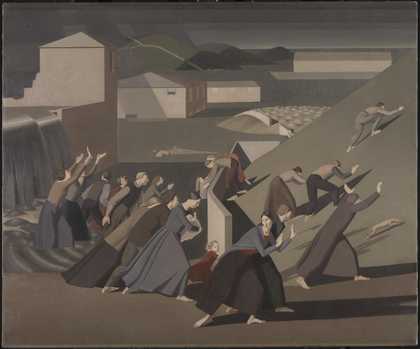
Winifred Knights
The Deluge (1920)
Tate
When I first saw Winifred Knights’s painting I thought it was an image of opposition, not flight. Those raised arms, their white hands scattering like doves; the people leaning in the foreground, braced at elbow and knee as if to take the weight of some terrible out-of-frame threat. The dynamism of their postures pulled my eye along the canvas, creating as it did the narrative of a community warding off imminent danger, as if that rising slope might continue tipping and crush them underneath.
But then I looked beyond the immediacy of the composition and discovered, despite its clarity, this was an artwork that revealed its details with a surprising subtlety. There at its heart, and yet strangely weak in presence, three diminished figures clung to a scrap of ground. Above them a building’s lower windows were partly obscured, bisected as if an excess of concrete had been poured about its walls. Another person, a child perhaps, could be glimpsed in a higher window. And that building close to the horizon - wasn’t it actually a boat? A windowless ark sliding out of sight? I returned to the people in the foreground that first so arrested me and followed the fearful glance of the central figure (based upon the artist herself). Casting her eyes over her shoulder, she looked back to where two sheets of cascading water poured in at the edge of the frame. The legs of the women nearby were surrounded by waves. Finally, I looked beyond the canvas and read the painting’s title on the wall: The Deluge 1920.
So this wasn’t a work of opposition after all. Those people with their arms raised weren’t fending off a future danger, but fleeing an existing one, caught within a clean-lined, almost Vorticist, image of chaos; a strangely structured depiction of destruction. This was not, as I’d thought, a post-war rendering of approaching apocalypse, but rather one of Biblical reboot, God’s corrective switching off and on of the world transposed into the modern style and dress of the day.
And yet, for me, it isn’t. My first impression of those angled bodies and the story they appeared to tell might have burned only briefly on my eye, but burn it did. So much so that now, whenever The Deluge swims into mind, it does so both as what it is and as what I thought it was.
I believe it’s this tension in my relationship with the painting that’s led me to associate its diagonals and shadows with a sense of aftermath more than event; that psychological and emotional state, especially in the wake of conflict, which is at one and the same time both a flight and an opposition - an escaping from past experience while also bracing for what lies ahead as a consequence. I should acknowledge, too, of course, an influence of context in shaping this association. To start with, there’s the date of the painting’s composition, undertaken by Knights as a competition entry in 1920, just two years after a war of previously unimaginable mechanised violence had come to an end. In light of that date, for me, the trapped and traumatised figures take on a new significance, caught as they are between the horrors at their back and the struggle for survival ahead of them. The whole image seems to transfigure under the pressure of the period. Those cascading sheets become more steel than water; the muted hues more military of tone; the dominance of women suggestive of a world culled of young men; that hummocked field resonant of a cemetery filled with recent dead.
This historical context is heightened if you view The Deluge within Tate Britain’s new curatorial pattern of decades. Follow Knights’s backward glance past those cascading sheets and out of the frame altogether. What does it meet? Edward Reginald Frampton’s retrospective Brittany 1914 c.1920, and the more literal images of the consequences of carnage in the pieces by Charles Jagger and William Orpen. Elsewhere in the room, too, out of her line of sight, the surrounding frames hold the work of other artists formed and informed by their recent experience of war, such as Paul Nash and David Jones.
Perhaps the most significant contextual influence, however, will always be personal. For my narrative poem Pink Mist I interviewed more than 30 recently returned wounded soldiers and their families. In these conversations I came to witness, at first hand, the landscape of psychological aftermath for which Knights’s painting finds a visual language - one of condemned confinement, of fragility and bracing flight. So it should be of no surprise that it was those voices I heard again as I stood before this painting and the trauma of its angled community.
Which is also where the echo of those interviews begins to break down. In The Deluge Knights presents, quite understandably after the all-consuming horror of the First World War, an image of a society suffering together. Most of the people I spoke to, however, have experienced the results of war in isolation. In our modern society we’ve ‘outsourced’ the damage of conflict to a professional military, often recruited from the poorer, more disadvantaged areas of the country. As a consequence, the terrain vague of aftermath is all too often endured alone, or within the intimate confines of immediate family. I wonder, were Knights to paint this image today, if this shift might be represented. If perhaps rather than a panicked, reaching crowd, just her own glancing, wary figure might remain, while those around her continued to go about their everyday lives - shopping, texting, watching, buying - oblivious to the individual at their centre, drowning, bracing and fleeing from the long shadow of conflict.
